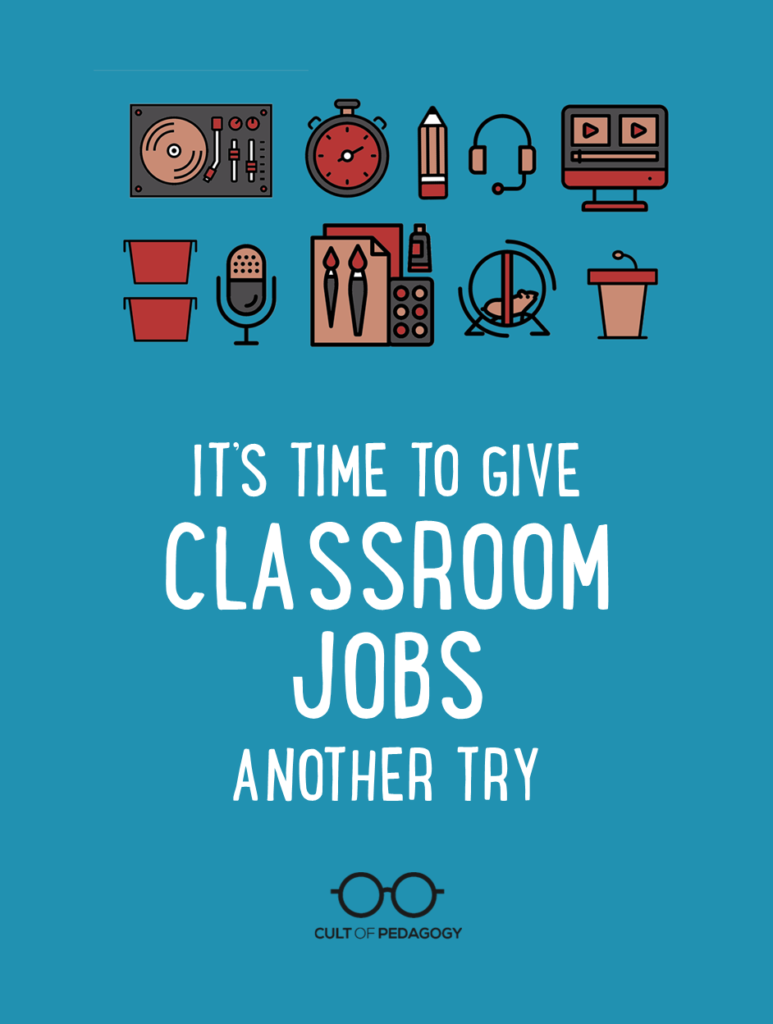
Listen to my interview with Thom Gibson (transcript):
Sponsored by Kialo Edu and Kiddom
This might be the perfect time for this topic. At first I just thought it was a neat idea, something teachers could implement pretty easily, something that would be a nice change of pace from what we usually talk about here.
But now I’m thinking this might actually be the thing that helps wake up a lot of our remote and hybrid classrooms from the white-knuckle, just-get-through-it mentality many of us have settled into as the ’20-21 school year grinds through its second half. Just maybe.
I’m talking about classroom jobs, the tasks we assign to students to help keep our classrooms running. This is typically something we associate with face-to-face classrooms during normal times, but I was absolutely delighted—and I don’t use the word ‘delighted’ every day—to learn that not only is it totally possible to assign jobs to students in remote classes, the jobs can make those remote classes really, really enjoyable. On top of that, they’ll help students discover and develop passions and talents they can take with them well beyond your class.
When I was a middle school teacher, I didn’t do much with classroom jobs. I was too much of a control freak, for one. The other reason was because it wasn’t really a part of middle school culture. Elementary teachers are fantastic about assigning jobs to students, but as kids get older, teachers use these kinds of systems less and less. As a result, secondary teachers often work themselves to the bone, doing everything themselves as their students, ironically, grow more capable of taking on responsibilities every year.
Now that I have talked with Thom Gibson about this topic, I wish I could go back to the classroom so I could put some serious effort into establishing a robust system of classroom jobs. Gibson is a middle school STEM teacher from Austin, Texas. He has basically mastered the art of managing a whole program of classroom jobs, and he’s made that process work for remote learning, too.

In our conversation on the podcast, we talked about why setting up students jobs is such a good thing to do, how to troubleshoot common problems with a jobs system, and what some of Gibson’s favorite classroom jobs are—once you hear some of these ideas, I know you’re going to want to try them.
Why Setting Up Classroom Jobs is Worth the Effort
- It builds positive classroom community and culture. “Students feel like they are actually contributing in a meaningful way that is helping you as the teacher or helping their fellow classmates with something,” Gibson says.
- It gives students opportunities to explore interests and develop talents. Gibson started to see more value in classroom jobs when he had students create things that could be shared with a wider audience, like podcasts, newsletters, and art. “I started seeing an opportunity to tap into the students’ interests with these class jobs as opposed to just getting something done for me.”
- It lets students learn job application skills. In Gibson’s class, students aren’t just given the jobs; they have to apply for them. So they gain experience with the job application process.
A Few Cool Job Ideas
Classroom jobs have really evolved past board cleaner and line leader. Gibson has compiled a list of over 25 unique student job titles. Here are ten to get you started:
- Podcaster: Produces a regular brief podcast on a topic of interest to students, using tools like Soundtrap or GarageBand to make it happen. To keep it manageable, Gibson recommends only having students do one podcast per month, and keeping each episode under 3 minutes.
- Athletic Trainer: Sets a timer for the middle of a class meeting to lead students in a movement activity, whether students are in the room or in a video meeting.
- DJ: Plays music for 5 minutes before class. This can be done through the videoconferencing platform if you are remote.
- Motivational Speaker: Records a one-minute Loom video each week reflecting on a motivational idea or quote to share with the class.
- Visual Display Artist: Creates posters for in-person class or graphics to be used online for remote learning.
- Zoologist: Cares for the class pet (or their own pet in remote learning) and lets the rest of the class check in once a week to see how the pet is doing.
- Tech Guru: Sets up the teacher’s classroom tech and helps other students with tech in-person, or troubleshoots and provides help to other students through screen sharing during virtual learning.
- KonMari Organizing Specialist: Keeps classroom supplies organized. This one works best in an in-person setting, but many teachers probably also have online spaces that could use help with decluttering.
- Assistant Grader: Helps the teacher with grading. In person, this student would highlight mistakes on assessments for the teacher to look at later. Virtually, this student could assist with some online grading and notify other students when assignments are missing from online platforms like Khan Academy.
- Tutorial Creator: Makes YouTube tutorials for all kinds of tasks that other students need in the classroom.
Making it Work: The Logistics
A system like this doesn’t just spring up out of nowhere; it requires organization and maintenance. Gibson shared a few key components of how his jobs program works:
- Job descriptions are provided ahead of time. Students first get a chance to look at all job listings, which include a description of each job along with notes on what personality types would be a good fit.
- Students apply for jobs. Gibson has found that this maximizes student buy-in. In the application, students choose their top three jobs and explain why they’d be a good fit.
- Job holders get checklists. After students are “hired,” (and multiple students may be hired for the same job), they are given job-specific checklists of responsibilities, including when their job is performed, how often, and how to do it.
- A teacher’s assistant keeps it all together. Although it was not mentioned in the above list, it is essential to have a teacher’s assistant whose job it is to remind everyone else to do their job. Gibson recommends looking for “super type-A” students to fill this role.
- Teach the jobs like any other curriculum. Students will need practice and feedback to do the jobs right. If a student isn’t doing their job correctly, “Make them do it again,” Gibson says, “not as a punishment but just as a way of, okay, so now let’s try it again.”
At a time when we are all hungry for human connection, when classrooms feel more fragmented than ever before, when we sometimes go days or weeks without talking to each other, adding classroom jobs to the mix could be the breath of fresh air we need for our schools. They will give students a new reason to show up, to participate, and to stick around, because in a meaningful way, the classroom will become theirs again.
Learn More from Thom Gibson
Gibson’s free course, Essential Student Jobs for the Middle School Classroom of Tomorrow, can be accessed here. His paid course, How to Teach Kids About Money Plus, is here.
Follow him on Twitter, on Instagram, or on YouTube.
Join our mailing list and get weekly tips, tools, and inspiration that will make your teaching more effective and fun. You’ll get access to our members-only library of free downloads, including 20 Ways to Cut Your Grading Time in Half, the e-booklet that has helped thousands of teachers save time on grading. Over 50,000 teachers have already joined—come on in.





Would love any fellow elementary educators to chime in with their recommendations to adapt these for younger students. Thanks so much! Best, Lucy R. 2nd grade teacher
Hi Lucy,
I’ve been retired for a few years, but I used a job application process with my first graders. Mini-lessons were integrated with our Social Studies unit around communities. Students learned about various jobs, the kinds of talents and requirements that each job required, how a community might be impacted when the job isn’t filled, and about the general application process, including getting the job and not getting the job. Then we applied all that to the kinds of work/jobs that contribute to our classroom community. Here’s a link to the job application that I used in my class. Clearly the job choices are from primary, but after reading the post, I’m sure there are others that could be included or swapped out. You’ll notice that kids were asked to rank all the jobs, not just their top 3 choices. This is because I needed more flexibility with the “hiring” process. Each student was guaranteed a job (most required 2 or more people) and some did get their last choice. (A proactive mini-lesson on how we respond to getting a job that wasn’t exactly what we wanted also took place. Kids did have the option to turn down a “job offer,” just as in real life, but that didn’t mean they’d get a different job. They had the option to wait until the next application round.) I only rotated jobs every quarter. This gave kids enough time to work out any kinks, grow at their job, stick with a job that maybe they got tired of, and to consider which job they’d want to do next time. It was also less work for me to change out jobs every few months. I would suggest sticking to them at for least 2 months.
There were some jobs that required more independence than others, such as traveling the hallway without a teacher. If a student wasn’t ready or qualified to have that independence yet, they were assigned a different job and we worked on the skills they’d need for the next application cycle. I think that’s about it, but if you have any questions, let me know. Hope this helps!
This is a great resource. This takes student jobs to the next level. Thank you for sharing.
I have always used jobs in my classroom – and I have some of the ones listed above, but I am excited to add a couple of new ones! I have always found it difficult to do the “application” process for the jobs – and am wondering how to do that without adding more to do… Right now I just ask for volunteers -and if nobody volunteers, that’s my job – but I only take on one and I assign the others. The students usually end up enjoying their job, but we change every month so nobody gets too bored and more are given the option to do the job. How do you streamline the application process?
I use a Google Form and they pick their top three jobs and for each one, they write why they would be a good fit for the job.
I then go through and try to assign them to one of those three (I have a separate document showing each job and listing the students underneath). It’s OK to have multiple students for a lot of the jobs.
Students are a little more bought in when they’re trying to make a case for why they’d be a good fit for the job.
I found this latest podcast very interesting and, like you Jennifer, I’ve often thought of classroom jobs as a neat idea and not something geared toward high school jobs. Recently, however, as a CTE coordinator, the simulated workplace is a trending concept. In this model, classrooms work as businesses or companies. We have been discussing how to implement this concept in our classrooms, and this organized classroom economy example, including an online banking system to pay salaries and charge rent, will allow us to really scale up our conversations. Thank you.
A classroom economy would be perfect for a CTE course. It could be a year-long / semester-long thing with ongoing conversations. In my classroom economy they can even ‘buy’ their desk so they don’t have to pay rent anymore and then they can watch their desk appreciate in value.
Why are we always trying to make more work for ourselves? I just have a jobs list and everyone rotates through the jobs. They are menial tasks, and I sure can’t spare the time to teach every student to be a podcaster…
APA,
I appreciate your thoughts and understand that assigning jobs such as a podcaster takes time to teach the skill. What about leveraging expert students in your classroom who already know how to do that job? Can you assign an “intern” or “assistant” to an expert student so that others learn the skill from their peer rather than taking up teacher time? I have not yet used this idea myself for class jobs, but I often use it when some students are in need of learning new technology tasks within my math class. I hope this idea helps!
I love this piece – enough with the negative comments. Jeez! It really rounds out the importance of classroom management that is more about engagement and buy-in, vs compliance. Well said!
I am currently a student teacher and have heard some of my mentor teachers talking about the use of student jobs in the classroom. Before student teaching, I never thought about giving students jobs in the classroom and what benefits it could have but now I see how important it can be. Reading your article only solidified my thoughts in wanting to implement this practice in my own classroom someday. Along with learning job application skills, building a stronger classroom community and opening doors to skill building and exploring interests as stated, I would add that it also gives kids a sense of autonomy which can ultimately benefit their learning experience. Thank you for this wonderful article!
Thanks for sharing, Isabella! Jenn will be happy to hear that the post was helpful for you.
I love this! Classroom jobs are an easy way to involve students in the classroom more, but in middle school it is harder to incorporate. The list of classroom jobs in this post are some that I would have never thought of on my own. Such as class DJ, athletic trainer, and visual display artist. I really like the idea of giving the whole class a list of classroom jobs and having them apply for their top 3. This way students aren’t assigned something they don’t want or it isn’t me randomly picking someone every time. I also love giving them a job description so they have something to go off of and then allowing the students to incorporate their own ideas into it.
These are exciting jobs for students to take part in. I hope to use some of these newer job titles in my classroom this year. I want students to feel that they belong in the class and are a functioning member. I often see students who seem left out, but implementing jobs will hopefully help remove this from my room.
I really enjoyed reading this post! I’m a current 2nd-year college student in Iowa studying to be an elementary school teacher. This summer I worked as a lead teacher in the school-aged room at a daycare, and I attempted to implement classroom jobs. It’s such a great idea to have the children apply for the jobs, then supply them with resources that describe their job. That’s genius! I will definitely be implementing that next time I have the opportunity. Thank you so much for sharing, Jennifer!
Carra, Jenn will be so glad to know that you found the post helpful. Once you’ve had a chance to implement it, we’d love for you to come back and tell us how it went!
Great blog!
Thanks! We’re glad you’re enjoying our content.
I enjoyed the list of jobs listed in the blog. Many of them I would never have thought of. I have found that classroom jobs can have a huge impact on how students view their classrooms. For many in middle school, they couldn’t care less and have a lack of community sense. Having students take ownership of their area and holding each other accountable has been a great thing to see for community building. Thank you for sharing these thoughts!
So glad you found the post useful! Best of luck in the coming year!